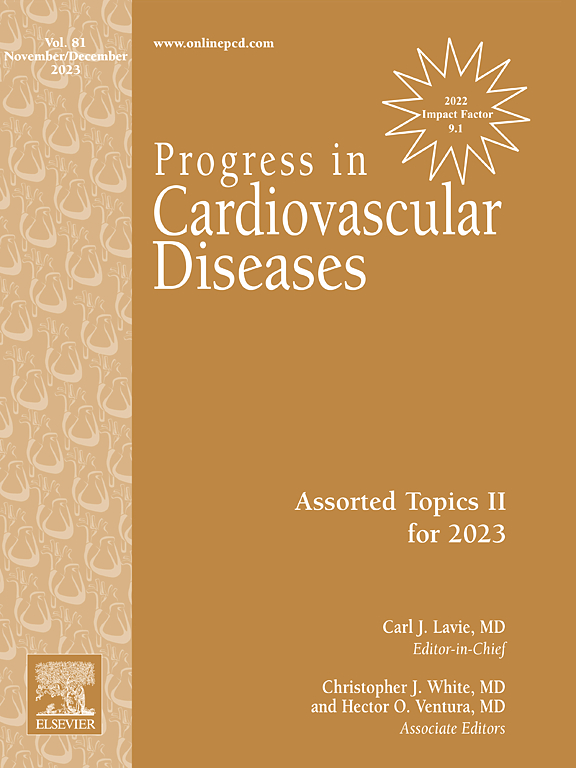心脏磁共振成像右室与左室容积比预测成人肺动脉高压不良结局的预后价值。
IF 7.6
2区 医学
Q1 CARDIAC & CARDIOVASCULAR SYSTEMS
引用次数: 0
摘要
背景:右心室(RV)功能影响肺动脉高压(pH)的临床结果,但用于早期检测和风险分层的无创工具有限。心脏MRI (CMR)衍生的左室与左室容积比(RV/LVvol ratio)通过将室大小与左室大小归一化,提供了左室大小的相对评估。然而,其预测效用仍未得到充分探索。在本研究中,我们研究了PH患者RV/LVvol比值与预后之间的关系。方法:这项前瞻性研究纳入了接受CMR的PH患者(超声心动图肺动脉收缩压 > 35 mmHg或有创右心导管平均肺动脉压 > 20 mmHg)。采用异常的RV/LVvol比值截止值(≥1.27),并采用建立的分级阈值进一步检验。主要结局是全因死亡率和心力衰竭住院的综合结果。结果:135例患者中,56例(41.5 %)的RV/LVvol比值异常。在平均1.9 ± 1.3 年的随访后,75名患者经历了主要结局。RV/LVvol比值异常的患者的主要转归率更高(64.3 % vs 50.0 %,p = 0.02)。在对年龄和CMR指数进行多变量分析后,异常的RV/LVvol比值与主要结局的高风险相关(HR 1.81[95 % CI 1.06-2.97]; = 0.003页)。RV/LVvol比值增加了随年龄增加的预后价值和传统RV指数(整体χ2值从6.7增加到17.4,p = 0.006)。结论:RV/LVvol比值是与PH患者不良结局风险增加相关的简单临床工具,提供了传统RV参数之外的预后信息。本文章由计算机程序翻译,如有差异,请以英文原文为准。

Prognostic value of the right ventricular to left ventricular volume ratio on cardiac magnetic resonance imaging in predicting adverse outcomes for adults with pulmonary hypertension
Background
Right ventricular (RV) performance impacts clinical outcomes across pulmonary hypertension (PH), yet noninvasive tools for early detection and risk stratification are limited. Cardiac MRI (CMR) derived RV to left ventricular (LV) volume ratio (RV/LVvol ratio) provides a relative assessment of RV size by normalizing chamber size to the LV. However, its prognostic utility remains underexplored. In the present study, we investigate the association between the RV/LVvol ratio and outcomes in patients with PH.
Methods
This prospective study included patients with PH (pulmonary arterial systolic pressure > 35 mmHg by echocardiography or mean pulmonary artery pressure > 20 mmHg on invasive right heart catheterization), who underwent CMR. Abnormal RV/LVvol ratio cutoff (≥1.27) was applied and further tested using established gradation thresholds. The primary outcome was a composite of all-cause mortality and heart failure hospitalizations.
Results
Of 135 patients, 56 (41.5 %) had an abnormal RV/LVvol ratio. After a mean follow-up of 1.9 ± 1.3 years, 75 patients experienced the primary outcome. Patients with an abnormal RV/LVvol ratio had higher rates of the primary outcome (64.3 % vs 50.0 %, p = 0.02). After multivariable analysis adjusting for age and CMR indices, abnormal RV/LVvol ratio was independently associated with the primary outcome (HR 1.81 [95 % CI 1.06–2.97]; p = 0.003). RV/LVvol ratio added incremental prognostic value over age and traditional RV indices (global χ2 value increasing from 6.7 to 17.4, p = 0.006).
Conclusions
The RV/LVvol ratio is a simple clinical tool associated with an increased risk of adverse outcomes in PH patients, offering prognostic information beyond traditional RV parameters.
求助全文
通过发布文献求助,成功后即可免费获取论文全文。
去求助
来源期刊

Progress in cardiovascular diseases
医学-心血管系统
CiteScore
10.90
自引率
6.60%
发文量
98
审稿时长
7 days
期刊介绍:
Progress in Cardiovascular Diseases provides comprehensive coverage of a single topic related to heart and circulatory disorders in each issue. Some issues include special articles, definitive reviews that capture the state of the art in the management of particular clinical problems in cardiology.
 求助内容:
求助内容: 应助结果提醒方式:
应助结果提醒方式:


